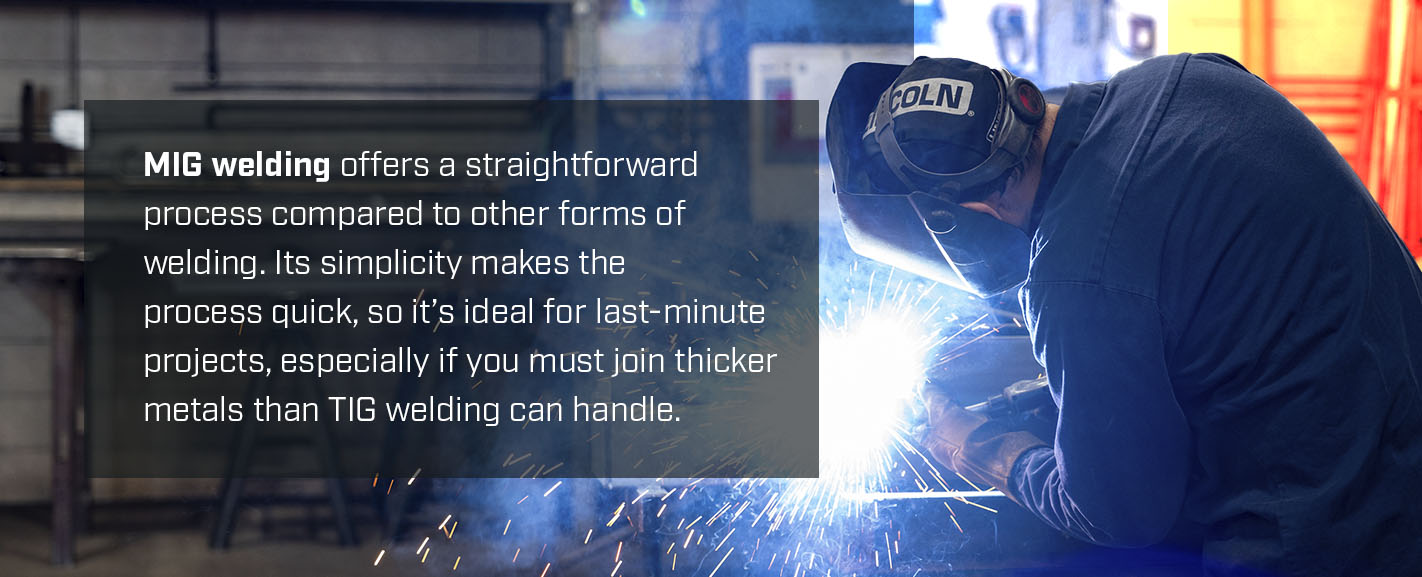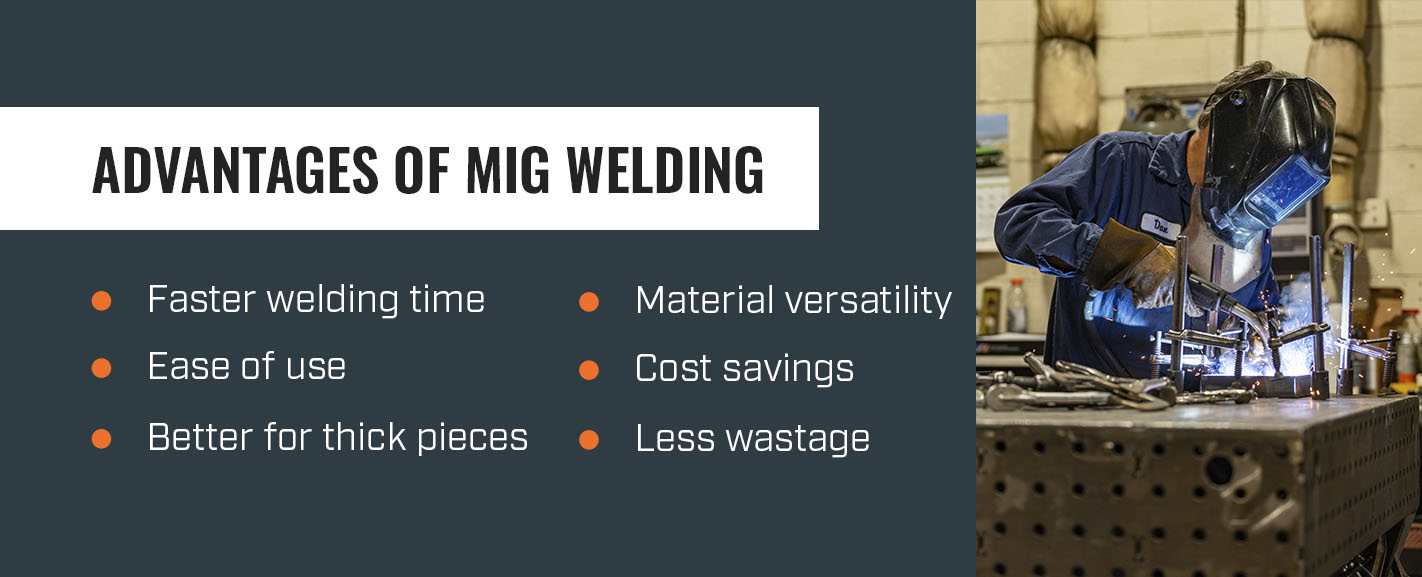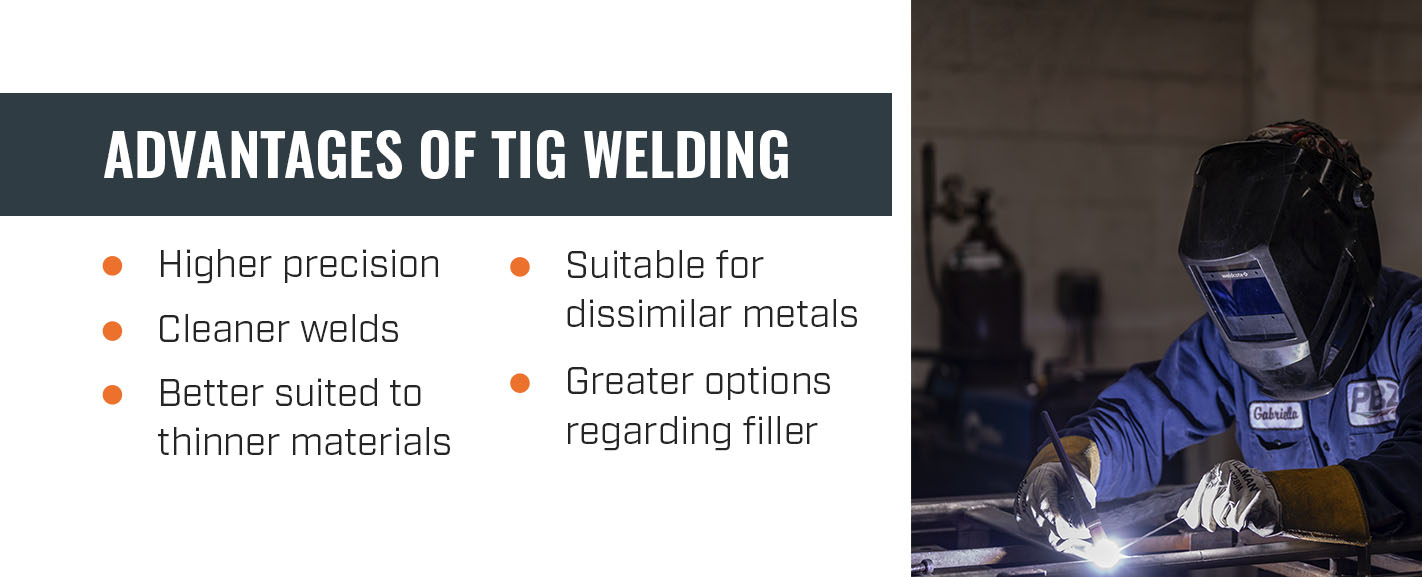
Joining metals together through welding gives you several options for the best method. Among your choices are MIG welding and TIG welding — both offering specific benefits in certain situations. The MIG vs TIG welding debate has been popular in the manufacturing industry for some time, and we’re here to provide the facts for each type of welding.
If you ever wondered what the difference is between MIG welding and TIG welding, this guide will cover everything you need to know.
Table of Contents
Both MIG and TIG welding create a weld by heating a metal surface with an electric arc. The difference lies in how the arc is used to join the metal surfaces. MIG welding uses consumable rods, also known as consumable electrode fillers, that the arc melts to produce a weld. TIG welding does not require a filler material — instead, it relies on a Tungsten tip to heat and join the metal surfaces directly.
Metal inert gas (MIG) welding also goes by the name gas metal arc welding (GMAW), and most welders learn this process first because it combines versatility with ease of use. Most metals and alloys adapt readily to the process.
The inert gas portion of the name comes from the fact the arc does not react to the oxygen in the atmosphere. A shielding gas surrounds the electric arc to prevent it from acting outside its designated area. This gas helps to increase the safety of MIG welding.
The welder uses consumable electrodes in the form of metal fillers. This metal will melt to connect the pieces of metal the welder wants to join. The type of electrode filler you use depends on the materials you need to join and their properties.

MIG welding offers a straightforward process compared to other forms of welding. Its simplicity makes the process quick, so it’s ideal for last-minute projects, especially if you must join thicker metals than TIG welding can handle.
TIG welding is an acronym for tungsten inert gas. Its other name is gas tungsten arc welding or GTAW. The name for the process comes from the tungsten electrode inside the welding gun. In MIG, this electrode is a consumable metal that creates the filler. Tungsten, however, melts less readily than other materials. It conducts the arc of electricity directly to the components you need to join.
Unless you touch the tungsten electrode to the weld pool or materials, you will not consume it during the process. Should the tungsten touch the metal, an incident known as dipping, you will need to grind off the tip. How often you accidentally dip the tungsten into the metal determines the life of the tip.
TIG requires two hands to weld, so in instances that use a filler, the welder controls the current using a foot pedal. Unless the welder regulates the current properly, the metals could get too hot. If the metals overheat during welding, they could crack from the stress.
Since TIG welding requires you to heat the metal pieces you need to join, the parts must be thin enough to allow the current to pass through them to reach the proper temperature. Very thick pieces require the filler used in MIG welding for a more secure bond.
MIG and TIG welding have several applications. Before identifying specific uses, though, be aware of the benefits and drawbacks of MIG and TIG welding to see how they suit themselves better for some projects. Although you may have a preference, it is helpful to know the pros and cons of each so that you can make an informed decision between these welding techniques.
Some of the advantages of MIG welding include:

Some of the drawbacks of MIG welding are:
Some of the advantages of TIG welding include:

Some of the downsides of TIG welding involve:
How does each process differ? Here’s an overview of how MIG and TIG welding work to give you a better idea.
The process of MIG welding starts with thoroughly cleaning the metal surfaces you need to connect. Any dirt or contamination on the surface could prevent the filler from adequately adhering to the metal. Even dirt under the metal clamps holding down the parts could impede electrical current through the system, reducing the effectiveness of the weld.
During welding, power flows through the welding gun to the wire. The weld sends an electric arc through the consumable electrode to the metal pieces. This process melts the consumable filler into a weld puddle that will cool and solidify to join the metal pieces.
Setting up the parameters for MIG welding depends on the metals you need to join.
The difference between pushing and pulling is that:
Unlike the MIG process, which only requires one hand to hold the welding torch, though two hands for steadiness is preferable, TIG welding requires two hands if using a filler material. While the filler is inside the welding torch in MIG welding, you hold it with one hand during TIG welding.
For the best TIG welding results, you should also try to ensure the cleanliness of the welded surfaces. Dirt causes serious complications with the weld, especially when using TIG without filler. Taking the time to clean the surface and to complete the weld will create a better weld than if you rushed through with dirty surfaces.
If you need a filler for the process, you hold a rod of the material in one hand while you have the torch in your dominant hand. You use a foot pedal to regulate the current through the welding gun.
TIG welding requires extreme care and precision. Don’t be afraid to take time. While a slower process, TIG welding produces much more aesthetically pleasing results.
In general, MIG welding is typically used for welding together thicker metals. MIG welding is also faster than TIG welding, making it a great option for applications that require speed. If you have experience with welding and need a strong, corrosion-resistant, visually appealing connection and have the time to devote to the process, choose TIG welding.
Here are specific applications and use cases for each welding type:
As long as you match the gas and wire to the types of metal you need to conjoin, MIG has a wide variety of applications you can use it for. Because it produces a visible weld line, choose it for projects that you can see from the outside or where the aesthetics matter.
Appropriate uses for MIG welding include the following:
These options for MIG welding show how versatile the process is. As long as your project does not need to look perfect, requires speed for finishing or has thicker metals that TIG welding won’t work for, you can choose MIG for your welding.
Since TIG requires extreme precision and produces cleaner welds, it’s best suited for applications where appearance and strength matter.
When choosing TIG welding, the parts must fit tightly together before welding them. If not, the weld will not correct any errors in fit since TIG generally does not use filler. Should the parts not have the desired fit, you can still use TIG if you do the welding with a pulsed current. While this may not fix problems with fit, it accommodates the parts better.
TIG welding has some applications required by construction codes. For many projects, a minimum of the first weld between parts must use TIG welding. These applications include:
Since TIG welds do not have visible filler when finished, they work well for piecing together:
These applications also value the corrosion-resistance and strength of welds TIG produces.
One use of TIG welding that showcases its strength and reliability is its use for spent nuclear fuel. After nuclear rods have completed their use, welders choose TIG welding to seal these still radioactive substances to prevent leaks of the material inside.
Welding is a vital part of any metalworking project. At PBZ, we understand this concept, which is why we hire only certified welders who can successfully do both TIG and MIG welding to fulfill the widest variety of jobs. These welders make up a part of our team, offering our customers resourceful manufacturing from design through shipping. If your business needs a comprehensive service, contact us at PBZ Manufacturing.
Updated March 12, 2024. Originally published November 4, 2019.
Manufacturing is in our DNA. Since Paul B. Zimmerman opened his small welding and repair shop in 1947, we've remained true to our roots: metal manufacturers serving in the Spirit of Christ. We're committed to carrying forward the service and business principles that brought us here. We're also passionate about advancements in technology and continuous improvements to meet your needs. It's why we have expanded our manufacturing and assembly capacity and added new flat and structural lasers.
Our new logo honors this legacy while signaling an exciting future of advanced capabilities and expanded capacity. We're committed to giving your ideas shape. What can we make for you?